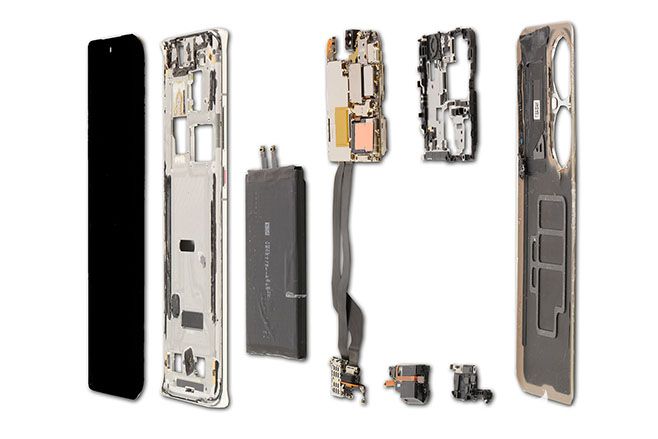Huawei P50 Pro, High Price Low Configuration?
Recently, major phone brands have released their flagship series for the second half of the year. The phones with camera under the screen are released one after another. However, the Huawei P50 series, which sold at $1,299, do not support 5G, which has caused controversy over overpriced. Let's take it apart to see if it is really at high price but with low configuration?

Teardown
Before disassembling, take out the SIM tray which has the silicone ring. The back cover is sticked with the glue. Although it is firmly sticked, the back cover can be removed by using the heat gun together with the pry piece. Both the back cover and the rear camera cover are equipped with foam, which works as buffer as well as to protect the camera.

Unscrew the screws, disconnect the BTB interface, and remove the main board cover, speaker module and sub-board. The sensor soft board interface is protected by a metal cover, and the color temperature sensor on the soft board is also covered with a silicone sleeve for protection.
Both the NFC coil and the wireless charging coil are pasted with a large area of graphite sheet for heat dissipation. The speaker module at the bottom is connected to the sub-board through a transfer cable, and a shrapnel board is attached to the front to connect the antenna.

The battery is fixed by plastic tape and has a lifting handle, which can be removed according to the prompts.

On the inner support, there are also a soft key board, a proximity & ambient light sensor board, a soft board connects the main and sub boards, a earpiece speaker and a fingerprint recognition sensor soft board, all of them are fixed by glue.

The screen and the inner support are fixed by glue, and the screen is separated after heating with a heating table. A large area of graphite sheet is attached to the front of the inner support, and the area of the liquid cooling tube is rather small.

Summary
The HUAWEI P50 Pro has a total of 23 screws fixed, which is a common three-stage structure, with moderate disassembly difficulty and strong reducibility. In terms of heat dissipation, the whole phone uses thermal grease + graphene + liquid cooling tube for heat dissipation, but the area of the liquid cooling tube is not large. P50 Pro supports IP68 waterproof, so the SIM card tray and USB interface are covered with silicone rings, which play a certain role in waterproof and dustproof.

After reading the disassembly and understanding the content of the structure, let's take a look at the information about Huawei P50 Pro devices.
Analysis:
First, let’s take a look at the motherboard. As the rear camera module accounts for a large area, for the design on the motherboard, P50 Pro uses a double-layer board design with high device integration.

We can notice that the thin parts on the outside of the main board are reinforced by metal reinforcement.When you open the shield of the motherboard, you can see that the processor & memory and power management chips on the front of the motherboard are coated with thermal grease for heat dissipation. Adhesive dispensing is also applied to the flash memory for protection.

In the process of analysis, through observation, we found that there is a layer stacked between the Kirin 9000 processor and the DRAM chip, and the DRAM chip used by the P50 Pro is a circle smaller than the lower Kirin 9000 processor. It is not difficult to think that due to some reasons, the original supply of DRAM chips used by the Kirin 9000 processor has been discontinued. The DRAM chips currently owned by Huawei naturally cannot match it, so this can only be used to add a layer of conversion between the two chips.

Finally, let’s take a look at the IC information on the motherboard.
Main IC on the front and back of the motherboard:

1: InvenSense-ICM-20690- six-axis acceleration sensor + gyroscope chip
2: Hisilicon-Hi6405-audio codec chip
3: Hisilicon-Hi1105-WiFi/BT chip
4: Toshiba-256GB flash memory chip
5: SK Hynix-H9JKNNNFB3AE-8GB memory chip
6: Hisilicon-Hi36A0-Hisilicon Kirin 9000 processor
7: Hisilicon-Hi6502-power management chip
8: Hisilicon-Hi6526-power management chip
9: NXP-SN100T-NFC control chip
10: Hisilicon-Hi6421-power management chip
11: NXP-TFA9874-audio power amplifier chip
12: Hisilicon-Hi6423-power management chip
Main IC on the back of the sub-board:

1: Hisilicon-Hi6365-RF transceiver chip
2: Murata-multiplexer chip
3: Hisilicon-Hi6D22-power amplifier chip
4: VANCHIP-VC7643-62-power amplifier chip
5: Murata-multiplexer chip
6: Murata-multiplexer chip
Combining the IC BOM of Huawei P50 Pro, it is found that compared with Mate 40 Pro, which also uses Kirin 9000 processor, the IC configuration is extremely similar. For example, the RF transceiver chip, WiFi/BT chip and audio codec chip are all the same.

Recent Posts
-
Step-by-Step Guide to Fixing a Samsung Galaxy S22 Screen
A cracked Samsung Galaxy S22 screen doesn't have to mean a costly repair bill. With the right tools …Nov 11, 2025 -
Why is my Android so slow? Speed it up in 5 minutes
Is your Android phone lagging, freezing, or taking forever to open apps? You're not alone. Over time …Oct 28, 2025 -
Why Does My Phone Keep Restarting? 6 Fixes That Work
Is your phone randomly restarting and leaving you frustrated? It’s a common issue that can happen wi …Oct 21, 2025




